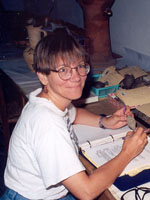Affiliation: Washington University

Ever since a 6th-grade ancient history class, Susan Rotroff has been fascinated by the Greeks and Romans. Latin was a favorite subject, and Rotroff’s early efforts included composing a soulful folk ballad on the wanderings of Aeneas. She first put spade to earth (actually, it was a trowel) at the medieval site of Wharram Percy, in Yorkshire. After graduating from Bryn Mawr, a year at the American School of Classical Studies at Athens gave her a hands-on introduction to Greek archaeology. As a Princeton graduate student, she began in 1970 to work at the Agora excavations. In three seasons, she dug Turkish and Byzantine houses, a classical building, and the garbage dump of Athens’ chief magistrates. She has published three volumes on the Agora’s Hellenistic ceramics. Recently, Rotroff has worked in Turkey on an underwater survey at Kaledran and the excavation of a Roman ship at Kizilburun. Since 1995 she has been on the Classics Department faculty at Washington University in St. Louis. Professor Rotroff was the AIA’s 2011/2012 Norton Lecturer.
A large, irregular boulder fenced off by a parapet of stone slabs lies at a crossroads on the north side of the Agora (the public square) of ancient Athens. When excavated, in the 1970s, it was covered with hundreds of small vessels, placed there in the latter part of the 5th century BCE, along with an eclectic collection of unusual objects, including gilded pebbles, knucklebones, writing styli, and fragments of broken sculpture. The lecturer and her colleagues at the Agora have embarked on a detailed study of the monument, now nicknamed the Crossroads Enclosure. Although it was located at one of the busiest spots in the city, its ancient identity remains a mystery. This lecture examines the architecture, contents, position, and environment of the Enclosure, looking for clues to that identity and the nature of the rituals and other activities that took place there, and placing it within its historical context in the turbulent last decades of the 5th century BCE.
Short bibliography and/or website on lecture topic:
J. Camp, The Athenian Agora: Excavations in the Heart of Classical Athens (London 1986), pp. 78-82
In ancient Athens, as today, people got sick. Suffering from anything from epidemic disease and accidents to chronic illness and passing indisposition, they required treatment. Much of what we know about that treatment comes from texts, particularly the body of medical lore known as the Hippocratic Corpus, which began to be written down in the 5th century BC. But the practice of medicine also left an archaeological trail, from the well-known healing sanctuaries to simple artifacts associated with medical treatment. This lecture examines some of this evidence, focusing particularly on objects preserved in the trash-heaps of Athens (and other cities) — including the equipment of a family of healers who lived just to the south of the city’s agora (public square) — to shed a more intimate light on the practice and practitioners of the healing arts.
See Susan Rotroff's work in the American Journal of Archaeology.